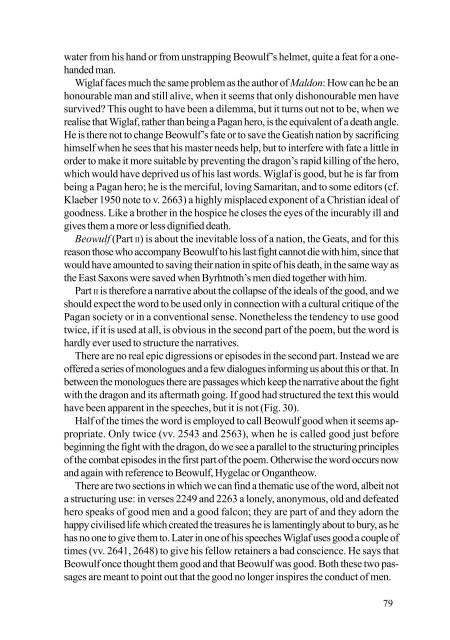Beowulf - Institutionen för arkeologi och antik historia
Beowulf - Institutionen för arkeologi och antik historia
Beowulf - Institutionen för arkeologi och antik historia
Create successful ePaper yourself
Turn your PDF publications into a flip-book with our unique Google optimized e-Paper software.
water from his hand or from unstrapping <strong>Beowulf</strong>’s helmet, quite a feat for a onehanded<br />
man.<br />
Wiglaf faces much the same problem as the author of Maldon: How can he be an<br />
honourable man and still alive, when it seems that only dishonourable men have<br />
survived? This ought to have been a dilemma, but it turns out not to be, when we<br />
realise that Wiglaf, rather than being a Pagan hero, is the equivalent of a death angle.<br />
He is there not to change <strong>Beowulf</strong>’s fate or to save the Geatish nation by sacrificing<br />
himself when he sees that his master needs help, but to interfere with fate a little in<br />
order to make it more suitable by preventing the dragon’s rapid killing of the hero,<br />
which would have deprived us of his last words. Wiglaf is good, but he is far from<br />
being a Pagan hero; he is the merciful, loving Samaritan, and to some editors (cf.<br />
Klaeber 1950 note to v. 2663) a highly misplaced exponent of a Christian ideal of<br />
goodness. Like a brother in the hospice he closes the eyes of the incurably ill and<br />
gives them a more or less dignified death.<br />
<strong>Beowulf</strong> (Part II) is about the inevitable loss of a nation, the Geats, and for this<br />
reason those who accompany <strong>Beowulf</strong> to his last fight cannot die with him, since that<br />
would have amounted to saving their nation in spite of his death, in the same way as<br />
the East Saxons were saved when Byrhtnoth’s men died together with him.<br />
Part II is therefore a narrative about the collapse of the ideals of the good, and we<br />
should expect the word to be used only in connection with a cultural critique of the<br />
Pagan society or in a conventional sense. Nonetheless the tendency to use good<br />
twice, if it is used at all, is obvious in the second part of the poem, but the word is<br />
hardly ever used to structure the narratives.<br />
There are no real epic digressions or episodes in the second part. Instead we are<br />
offered a series of monologues and a few dialogues informing us about this or that. In<br />
between the monologues there are passages which keep the narrative about the fight<br />
with the dragon and its aftermath going. If good had structured the text this would<br />
have been apparent in the speeches, but it is not (Fig. 30).<br />
Half of the times the word is employed to call <strong>Beowulf</strong> good when it seems appropriate.<br />
Only twice (vv. 2543 and 2563), when he is called good just before<br />
beginning the fight with the dragon, do we see a parallel to the structuring principles<br />
of the combat episodes in the first part of the poem. Otherwise the word occurs now<br />
and again with reference to <strong>Beowulf</strong>, Hygelac or Ongantheow.<br />
There are two sections in which we can find a thematic use of the word, albeit not<br />
a structuring use: in verses 2249 and 2263 a lonely, anonymous, old and defeated<br />
hero speaks of good men and a good falcon; they are part of and they adorn the<br />
happy civilised life which created the treasures he is lamentingly about to bury, as he<br />
has no one to give them to. Later in one of his speeches Wiglaf uses good a couple of<br />
times (vv. 2641, 2648) to give his fellow retainers a bad conscience. He says that<br />
<strong>Beowulf</strong> once thought them good and that <strong>Beowulf</strong> was good. Both these two passages<br />
are meant to point out that the good no longer inspires the conduct of men.<br />
79








